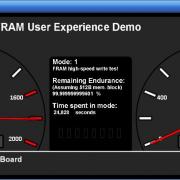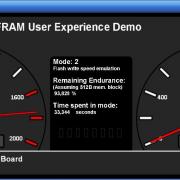Over a week ago, I got a notice that Texas Instruments (TI) is giving away a 50% coupon for MSP430_FRAM related devices. Without hesitation ordered their MSP-EXP430FR5739 TI experimenters board that price went down to $14.50, including free shipping.

With all functionality and onboard peripherals included – it’s a giveaway. The experimenter’s board came in an excellent complex paper package that feels really solid and professional in hands.
Surprisingly (or not), TI didn’t limit inside contents with only the development board. It also contained a small flayer with a fast start note, Mini USB-B cable, a couple of 10 pin female headers, a tiny bent 6 pin male header, and a 32.768kHz SMT microcrystal.

About this 6 pin connector – it seems that TI guys made a mistake when packing contents. This isn’t mentioned in the description, but thanks anyway – I will find where to use it.
MSP-EXP430FR5739 board layout
As a development board for such a price MSP-EXP430FR5739 board has some valuable stuff on it. It is split into three regions, where the first is dedicated to debugging and programming. There is a dedicated MSP430F1612 microcontroller used for this. It communicates to the PC via USB. IT uses a dedicated serial to USB converter chip (TUSB3410). With proper Jumpers, It also can be used for application USART communications. Probably the most interesting area is a development with many features. The center of this is an MSP430FR5739 16-bit microcontroller with 16KB FRAM and 1KB of SRAM. Additionally, there are:
- eight LEDs;
- MTC thermistor;
- 3 axis accelerometer;
- the footprint for LDR resistor;
- pin connections
- two programmable buttons;
- reset switch.
The third part of the board is for connectivity. There are connectors for Wireless daughter cards (Ccxxxx RF) and connection to the MSP-EXP430F5438 board, which can also be used for prototyping if not used on purpose.
Probably one thing is missing on the package – a software CD. I know everything can be downloaded, but this would free for additional downloading of CCS, which is quite significant for slow internet connections.
Development software and demo code
To start using the MSP-EXP430FR5739 board, you’ll need to download a couple of packages from TI’s website. The first one is a source code package that also contains drivers for serial to USB bridge, GUI, to display demo programs (source code of GUI included).
Here are demo screens for Demo application mode1:
and mode2:
As you can see from tests – FRAM writes speed reaches almost 1,8MB/s while Flash write rate is around 10kB/s. And endurance of FRAM decreases much slower than Flash.
For developing applications, we will use Code Composer Studio, which is free for code size limited applications. The limit is set to 16KB, which is the maximum of an outboard. Practically no limitations for us this time.
How FRAM works
And at the end of this review, let’s see at a glance what is a FRAM (FeRAM) memory. It’s so-called Ferroelectric Random Access Memory, which is nonvolatile. This means it retains its contents even if power is removed. FeRAM storage cell is similar to DRAM, where capacitor and access transistor are used. But in the FeRAM cell capacitor, a ferroelectric material referred to as PZT (lead zirconate titanate) was used.
As the electric field is applied across the capacitor, PZT changes polarity according to electric field position and maintains polarity until it’s changed with a new e-field pulse.
FeRAM is a low power nonvolatile memory. Compared to Flash, it is over a hundred times faster than flash memory, and its power consumption is shallowly comparing to Flash or EEPROM. Additionally, its endurance is practically unlimited (rated as 100 Trillion R/W cycles). This makes it ideal for replacing Flash and EEPROM memories.
Sounds really attractive, but according to Wikipedia, some technical issues stop the mass transition to FeRAM. First of all-flash memory density is much higher than FRAM, and also, it is much cheaper to bake Flash memories as the technological process is quite well developed. Ferromagnetic materials used in FRAM have some issues with CMOS compatibility and silicon contamination. Despite these facts, we have working examples of MSP430 FRAM microcontrollers. With even more low power, they are more attractive for portable and battery-operated projects.



